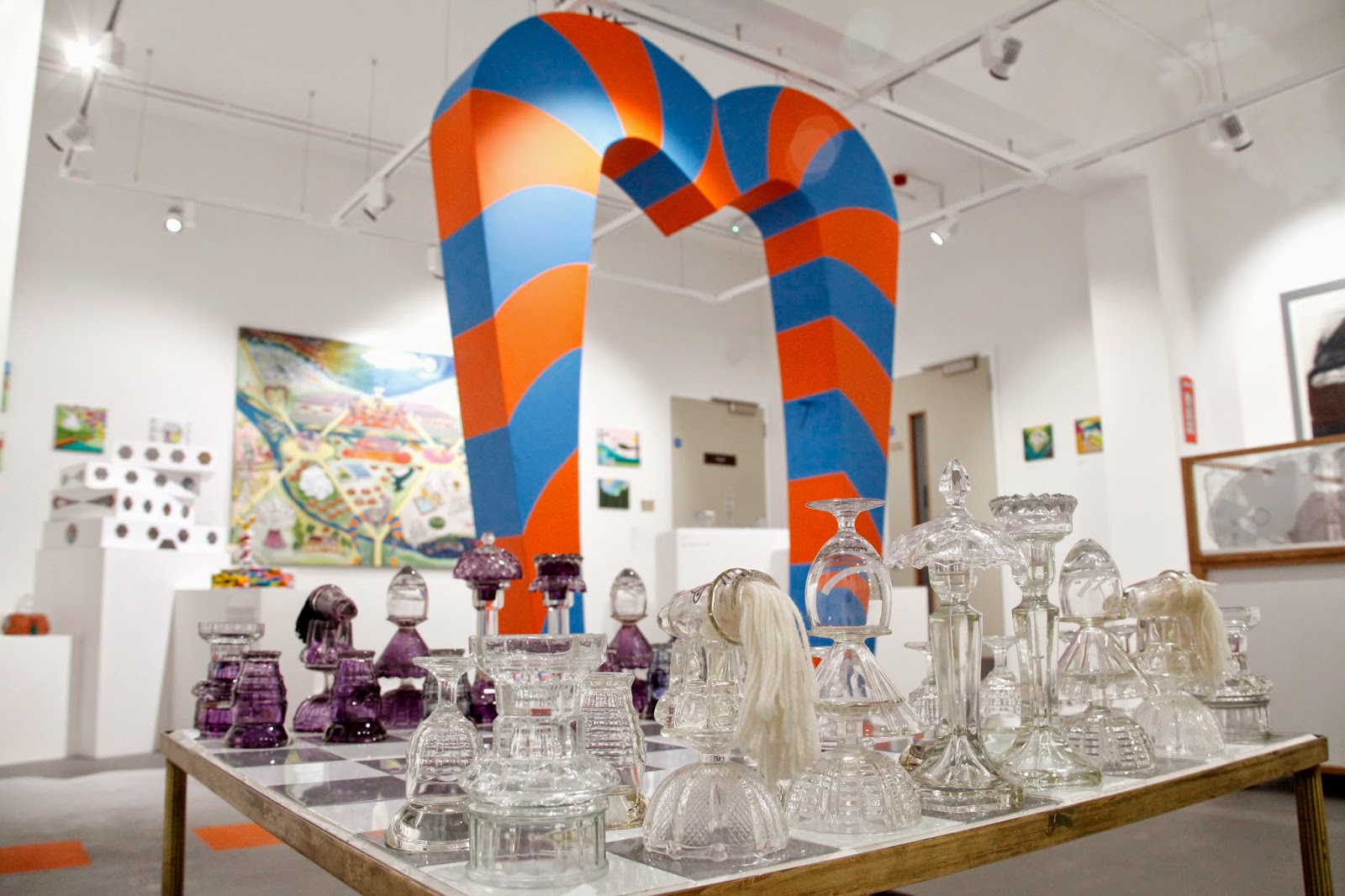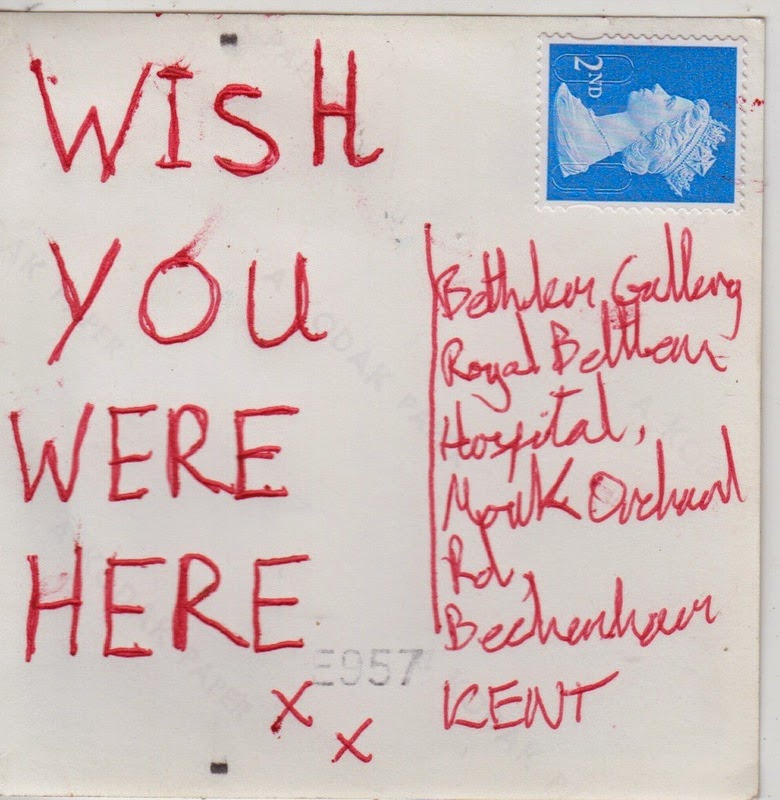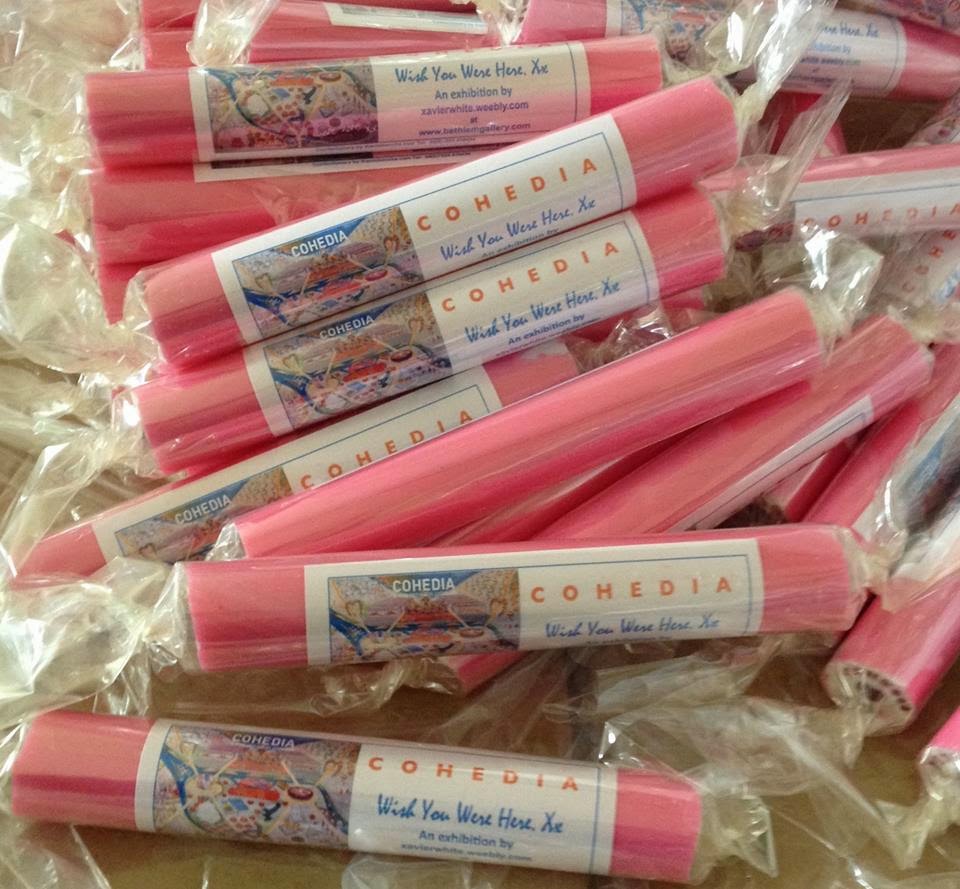20/04/15
Xavier White: Cohedia… wish you were here Xx
Bethlem Gallery
15 April – 15 May 2015
What is Cohedia? A
shape, a colour, a solution, an answer? Where is Cohedia?
We are all on a journey, marking out our route through life.
Sometimes our paths cross with those of others, for better or worse, leading us
astray or guiding us on our way. We are all looking for answers, wondering
where our ultimate destination will be. Xavier White’s journey has been a particularly
difficult one since, at the age of 18, he suffered a near fatal head injury while
cycling home through Peckham and fell into a 10-day coma, after which he had to
relearn even the most basic life skills. He has spent the 30 years since this time working
creatively with a number of subtle but disruptive consequences of his brain trauma.
I got to know White four years ago and, since then, each crossroads at which
our paths have met has been an adventure and an inspiration.

Cohedia is White’s vision of a kind of utopia, ‘a mind-expanding cityscape’, ‘a jewel of an
idea, polished with time and thought’ and ‘a speculative environment’. He has
mentioned it to me often during the time I have known him and sometimes I’ve even
seen glimpses of it and confronted elements from this other world. But now, for
the first time, Cohedia is portrayed in its (current) entirety – Cohedia at a
point of cohesion – in the new Bethlem Gallery, part of the South London and
Maudsley NHS Foundation Trust (SLaM), which also incorporates the Maudsley
Hospital, where White began his journey all those years ago, in their
Neurosurgical Unit, after regaining consciousness.
As you enter the gallery, you are met by a stained glass
window, Carpe Diem Cohedia (2015), in medieval style, depicting a
portrait of White on his bicycle, with the destination of Cohedia marked across
a basket on the front. This relates to what White terms his ‘personal
experiential learning journey’ and it guides visitors on their way.

The centrepiece of the exhibition is a huge canvas, Cohedia: A Mind-Expanding Cityscape (2003-ongoing).
To enter the Cohedia headspace and get a sense of the buildings and characters
depicted, there is an audio soundtrack, which can be listened to through
headphones as you wander around the show. To reach this point you must first
pass under a gateway arch – ‘a monolith-like entrance’ – that represents
harmony. You are then free to explore, finding repeated elements – characters
and structures from the large cityscape – on smaller canvases dotted about the
white walls. 3D sculptures of the snail-like homes, Escar Abodes (2004-2015); the Sankara
Canopy (2015), which, taken from the
Buddhist word meaning the sum of all the properties equals existence, houses
the market in Cohedia; a lego construction of The Ark of Art (2015), which has a multiplicity of functions,
including as a gallery, a warehouse and a venue for raves; and a model of the University of Understanding (2015),
whose shape has been abstracted from a stack of books, the traditional carriers
of knowledge. Everything in Cohedia has been thought out to the most minute
detail and truly is a mind map of what is going on inside White’s head. For
anyone prepared to take the time to explore, however, I’d suggest throwing away
that map and plunging in to see where you might unexpectedly end up.
Afterwards, you can even plot your own route through the gyrus (ridges) and sulcus
(valleys) on Everest – Brain Journey
(2015), an interactive map, which allows you to personalise your visit.

The exhibition also displays some of White’s breathtakingly
exquisite glass works, including Make
Your Move (2009), a chess set crafted out of vintage glass items, sourced
from Deptford market. For White, the fragility of the medium, prone to shatter
at the slightest mismanagement, might be seen as a metaphor for life, while the
game of chess itself speaks of cognition and decisions about which path to take
and which move to make. Visitors are invited to play, to ‘make their own move’.

There are so many more works which could be mentioned, not
least the numerous drawings and a large piece, Think About It (2014), which represents the movements of the
neurotransmitters in your brain as you stand there pondering. Then there are the postcards sent to
Bethlem in advance of the show – all signed off with ‘Wish you were here Xx’ –
and the beach area beneath this display, with glass globes (minus one, which
now stands proudly on my desk), Excalibur
(2000-2004) and Washed Up Trapped (2015),
a message in a bottle. These heavy glass pieces are ironically most unlikely to
float or indeed be washed up on a beach. They are another example of White’s
wry sense of humour and his contradicting expectation – perhaps a reflection on
the sub-surface struggles he still encounters in his daily life.

To complete your visit, you are offered a Cohedia… wish you were here Xx stick of rock.
The only way to even begin to comprehend the magnitude of this project – upon
which White has been working for many years – is to visit for yourself and take
the time to really explore. After all, he does wish you were there.

Images courtesy the artist and Bethlem Gallery